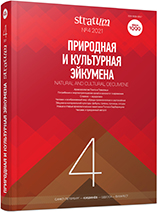Двурогие пластинчатые лунницы римского времени в Крыму: распространение, датировка (по материалам могильника Фронтовое 3)
Two-horned Lamellar Lunulas of the Roman Period in the Crimea: distribution, dating (by materials from the Frontovoye 3 Burial Ground)
Author(s): Anna V. Mastykova, Alexey N. SviridovSubject(s): History, Archaeology, Ancient World
Published by: Издательский дом Stratum, Университет «Высшая антропологическая школа»
Keywords: Crimea; burial ground; Roman period; lunula; chronology; distribution;
Summary/Abstract: The article addresses two-horned lamellar silver lunula pendants of the late Roman Period, found in burials 13 and 94 of Frontovoye 3 burial ground in the South-West Crimea. The distribution of lunulas of similar types in the Crimea and adjacent territories, their dating and methods of wearing have been studied. In most cases, these pendants are found in burial complexes of the second half of the 3rd century in Crimea, on the territory of Northern Dagestan, in Kalmykia and in the basin of the Lower Don. At the same time, for the Crimea and the Sarmatian steppe, the data of the lunulas serve as chronological indicators for the second half of the 3rd century. One of their variants (no. 3) from Frontovoye-3 burial ground is more typical for the Crimea, rarely found outside its borders and has an earlier dating, within the first half of the 3rd century AD. Methods of wearing lunula pendant with the costume of those buried in Northern Dagestan, Kalmykia and the Lower Don differs from their use in the Crimea. In the area between the Don, the Volga and the Caucasian ridge, lunulas are usually found in necklaces, where they are combined with spiral-shaped bronze beads ending in 14 sided beads, usually carnelian. However, such necklaces are completely absent among the Crimean burials.
Journal: Stratum plus. Археология и культурная антропология
- Issue Year: 2021
- Issue No: 4
- Page Range: 231-243
- Page Count: 13
- Language: Russian
- Content File-PDF

